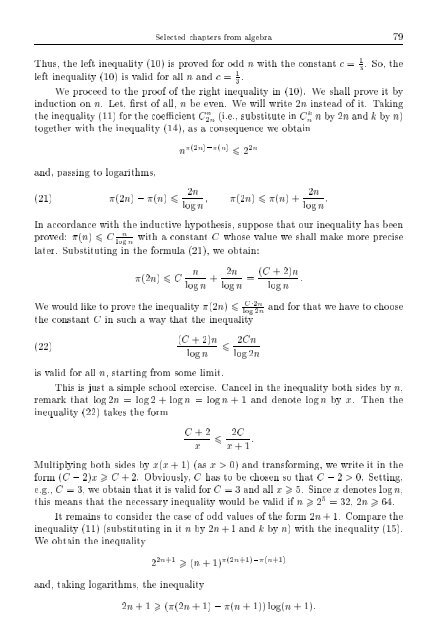SELECTED CHAPTERS FROM ALGEBRA I. R. Shafarevich Preface
SELECTED CHAPTERS FROM ALGEBRA I. R. Shafarevich Preface
SELECTED CHAPTERS FROM ALGEBRA I. R. Shafarevich Preface
You also want an ePaper? Increase the reach of your titles
YUMPU automatically turns print PDFs into web optimized ePapers that Google loves.
Selected chapters from algebra 79Thus, the left inequality (10)isproved for odd n with the constant c = 1 . So, the3left inequality (10) is valid for all n and c = 1.3We proceed to the proof of the right inequality in (10). We shall prove itbyinduction on n. Let, rst of all, n be even. We will write 2n instead of it. Takingthe inequality (11) for the coecient C2n n (i.e., substitute in Cn k n by 2n and k by n)together with the inequality (14), as a consequence we obtainand, passing to logarithms,n (2n);(n) 6 2 2n(21) (2n) ; (n) 6 2n2n (2n) 6 (n)+log n log n :In accordance with the inductive hypothesis, suppose that our inequality has beenproved: (n) 6 Cnlog nwith a constant C whose value we shall make more preciselater. Substituting in the formula (21), we obtain:(2n) 6 Cnlog n + 2n (C +2)n=log n log n :We would like toprove the inequality (2n) 6 C2nlog 2nand for that we have tochoosethe constant C in such away that the inequality(22)(C +2)nlog n6 2Cnlog 2nis valid for all n, starting from some limit.This is just a simple school exercise. Cancel in the inequality both sides by n,remark that log 2n = log 2 + log n = log n +1 and denote log n by x. Then theinequality (22)takes the formC +2x6 2Cx +1 :Multiplying both sides by x(x + 1) (as x>0) and transforming, we write it in theform (C ; 2)x > C +2. Obviously, C has to be chosen so that C ; 2 > 0. Setting,e.g., C =3,we obtain that it is valid for C =3andallx > 5. Since x denotes log n,this means that the necessary inequality would be valid if n > 2 5 = 32, 2n > 64.It remains to consider the case of odd values of the form 2n +1. Compare theinequality (11) (substituting in it n by 2n +1and k by n) with the inequality (15).We obtain the inequalityand, taking logarithms, the inequality2 2n+1 > (n +1) (2n+1);(n+1)2n +1> ((2n +1); (n + 1)) log(n +1):
















